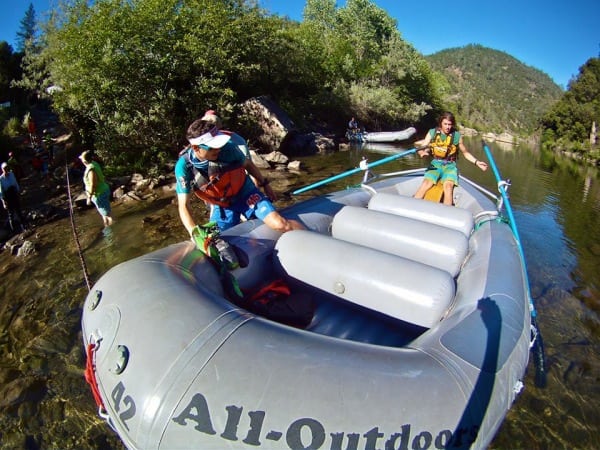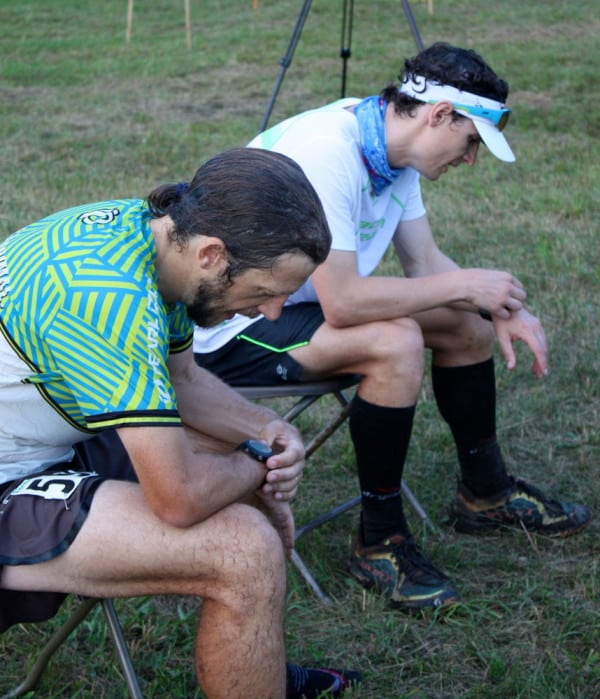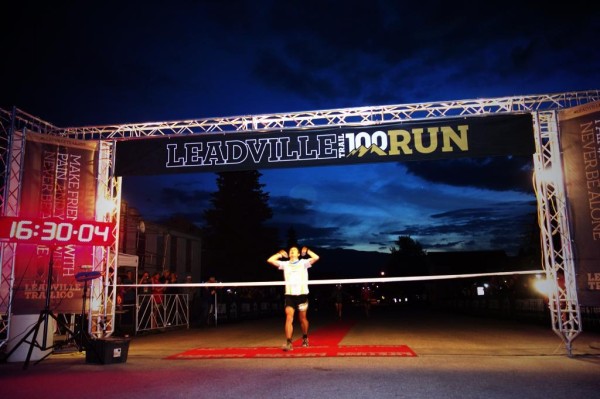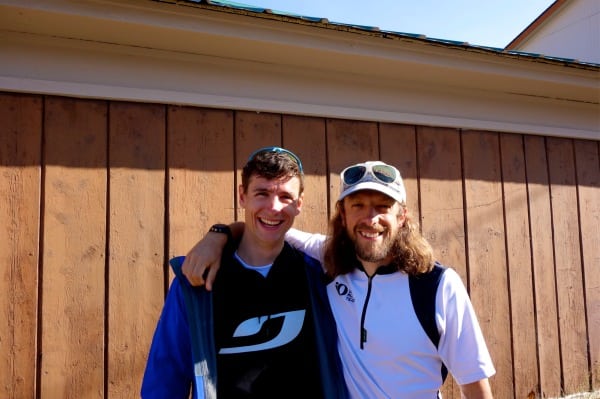The Idea
After my third Western States in 2012, I decided that I wanted to have a different focus for the next summer, but I had still run my way into the 2013 race from finishing in the top 10. To me, the obvious next challenge was to run the Grand Slam–Western States 100, Vermont 100, Leadville Trail 100, and Wasatch Front 100, all in the same summer. Being a naturally competitive guy, I got Neal Gorman‘s 2010 record time (74 hours, 54 minutes, 16 seconds) in my sights as a target and I started planning ahead many months before 2013. When I heard several fast runners were also considering chasing the record, namely Nick Clark, Karl Meltzer, and Neal himself, it suddenly got a lot more interesting. Unfortunately, only Nick decided to run all four races, but I’ve had plenty of close races with him and we’re good friends, both hailing from the UK. So I expected it to be a tight and exciting battle, probably only decided in the final round.
However, I’ve started this story in the middle since what first piqued my interest was when I was living back in the UK and read a book called Running Through The Wall: Personal Encounters With The Ultramarathon by Neal Jamison which had a write-up about this ridiculous challenge, something that seemed even more extraordinary to me since I’d barely run a couple of middle-distance ultras at the time and hadn’t even considered 100s. I asked myself how people could do that much damage to their bodies and still keep running. Did they suffer from the effects for years? Did it turn them into permanently slower runners through such extreme muscle damage?
Well, when I read that book I had no desire to find out and it seemed more like a crazy idea than something I’d ever consider. Mind you, at that time I didn’t think I’d ever be tempted by running a 100 miler either.
Training
Since I’d already trained hard in previous years for Western States, I reasoned I couldn’t do much more if I wanted to avoid burnout. Instead I learned lessons from my weaknesses at previous 100 milers and aimed to train as hard and as specifically as possible for Western. Then I hoped that a combination of being fit for the first race, plus doing a 100-mile ‘training run’ every three to four weeks would be enough to keep my body prepared to the end. In-between the 100s, I planned to run very little, do no races (trust me, that was a hard one to stick to), and hike in place of running.
Each of the races has specific elements that need to be trained for, but they all involve hills and endurance so that was the main theme for my Western build-up. In addition, the races could be summarized as hot (Western), humid (Vermont), high (Leadville), and hell (Wasatch… it was also hot and high!). Given Wasatch has by far the most amount of climbing, I reasoned that the other races would help with training my legs. The others involved some additional tactics: saunas and runs with multiple layers on for Western, pacing at Badwater in Death Valley for Vermont (in hindsight, not a good idea four days pre-race), and two weeks at altitude in Colorado for Leadville.
What I hadn’t planned on was picking up a knee injury in December, then trying two 100-plus mile races on that immediately after. I had to concede by February that I needed a rest and some physio, so took that whole month off. The following months were also purely aimed at turning up to Western in the best shape possible, so I raced less than usual and treated those races as a chance to get fit instead of trying to peak for them. By early June, I felt fit but nervous about what the next few months would bring. Then I sprained my ankle and was worried about whether I’d even be able to start the Grand Slam. By the end of June, I’d done a few test runs on the ankle and decided it might hold up on the trails and I had to try at the least.
Western States 100
The first race went well, despite highs of around 110 Fahrenheit on the course. The early miles were spent enjoying what felt like a fun run in the mountains with friends as the pace wasn’t too hot and the leaders didn’t spread out much until about half way. Thanks to using every opportunity to cool myself with ice from aid stations and immersing myself in stream crossings, I just about avoided overheating.
As with every 100 miler, there’s a point where it really gets tough and it seems like there’s no way the body can continue. I usually find this happens about 12 or 13 hours in and that was the case again. By this point, I was in fourth but had Dylan Bowman right behind and Nick Clark chasing him. Dylan kept driving me to the finish, especially after I saw him board the boat at mile 78 to cross the American River just as I emerged from lying in the shallow water on the other bank of the river.
I put my head down and grunted my way to a 16-hour, 20-minute finish to hold on to fourth (full race report), with Dylan 12 minutes back and Nick 36 minutes back. Race one was over; I was uninjured and the ankle had been noticeable but not an issue. Now, how well would I recover for Vermont in three weeks?

Ian crosses the American River during Western States. Photo: Gary Wang
Vermont 100
In hindsight, I didn’t have the best preparation for Vermont. I flew to Death Valley and crewed/paced Glen Redpath just days before the race then took a red-eye to the east coast only to sleep in a small rental car during a thunderstorm for the 4 a.m. start. The early miles felt okay in my legs but I had stomach problems from eating way too much at the pre-race pasta dinner. Such a basic mistake that I really shouldn’t have made.
By about mile 30, I was in about eighth and could see Nick ahead but I felt rough. Not like a bad phase, but like I was near the end of the race and had nothing left to give. The high humidity didn’t help and the hills therefore were more draining than they appeared in the course profile. Even though this race is the flattest of the Slam races, it still has around 14 or 15,000 feet of ascent and the hills were relentless, although never huge.
I kept asking for updates about where Nick was but I was in survival mode as he got almost 20 minutes ahead of me early in the second half. It was turning into a miserable day after I’d expected it to be the ‘easy’ 100 of the four. However, I’d prepared myself mentally in advance for having to grind out a day gone wrong and the priority was to finish and to be as close to Nick as possible.
It was a sufferfest from about that 30-mile mark but the miles kept going by and my pace wasn’t slowing much, despite the annoying pain and fatigue. Miles 70 to 80 were a low for me and I kept calculating how long it would take to finish if I walked every step to the end as it seemed a real possibility. Yet somehow I didn’t feel any better but I was able to run more. I moved into fifth, then fourth at about mile 93, and was catching Nick up. He was in third and reports from aid stations told me he was having a bad day, too. So all I could do was run every step possible and see where it left us both at the finish.
The result was Nick finished in 15 hours, 54 minutes in third to my 15 hours, 57 mimutes for fourth (full race report). Not the times we both wanted but still over two hours under the Slam record splits in total and I had a reduced lead of 33 minutes. Clearly my thoughts about it being a summer of back-and-forth racing against Nick were right.

Nick and Ian after finishing Vermont. Photo: Far North Endurance
Leadville Trail 100
Leadville is the biggest 100-miler in the US and had around 900 starters this year. I know the logistics weren’t perfect for the majority of runners but at the front we didn’t have problems. Hopefully they can fix things for next year. The Grand Slammers had a luxurious four-week gap between races and I certainly felt better than at Vermont, but was very worried that I might end up doing another full-day grind and really not enjoy it. The fact that much of the course is above 10,000 feet also didn’t bode well for a sea-level dweller like myself, but I had two weeks of hiking in the Colorado San Juans to help boost my red blood cell count.
Several fast runners were on the start line and aimed to run very quick times, so Nick and I were expected to be a little off the pace and to be more of a sideshow instead of the main event. Ryan Sandes was back after winning the race in 2011; Scott Jurek was returning to 100-mile racing and has a pedigree that can’t be ignored; plus kiwi Olympian Mike Aish was looking for redemption after DNFing the previous year.
So Nick and I were ready to do our own thing and keep the pace sensible early on. However, the others also did this and on the singletrack in the dark, I found myself tripping over runners in a conga line and decided to take the lead into the first aid station. Mike Aish pounced soon afterward to take over at the front and build up a large margin by halfway, but the chase pack was running fairly comfortably with Ryan looking the strongest.

Ian and Nick running into Twin Lakes outbound. Photo: iRunFar/Bryon Powell
I was surprised how flat the course is and it’s really just made of three climbs on the way out and steeper versions of those climbs on the return 50 miles. Nick and I spent most of this time within a minute or two of each other, mainly with him leading. Then at Twin Lakes aid station at 39 miles, he stopped momentarily with his crew and I kept going to head up the first ascent of Hope Pass, summitting at 12,600 feet. That climb was surprisingly okay for me, although I did powerhike every step. I passed a few guys and, at the top, was in second. A glance over my shoulder showed Nick a minute back and Ryan just behind him, so I assumed the race was on and that the main contenders were in position. Scott was farther back due to stomach problems and never got back into the chase for the win, unfortunately.
This far into the race I was pleasantly surprised to still be feeling good and to be having a much better day than at Vermont. At the turnaround at Winfield, I was about 10 minutes back from Mike and five ahead of Nick, while Ryan dropped at this point with back problems. All I can say about the next 50 miles is that it’s very stressful having someone as determined as Nick chasing you down. There was no doubt that, if I faltered then he’d catch me, which gained more significance when we both passed Mike before the 70-mile aid station.

Ian cruising 70 miles into Leadville. Photo: iRunFar/Bryon Powell
Unexpectedly, Nick and I were not just racing for times in round three of the Slam, but also for the win. Neither of us could know how much the other was feeling the effects of the previous two 100s, but it’s usually a safe bet that he won’t slow down even when he feels like death. Must be that rugged mountain beard giving him Samson-like strength.
My body started deteriorating at mile 85 as I became delirious and began tripping over rocks. By the final aid station at 86.5 miles, I’d slowed and my lead fell from about 16 minutes to 10. At this rate he’d catch me, so when I found out about that gap (about six miles later), I ran like I was being chased by a mountain ‘tiger’… which I was (check out Nick’s mountain ‘tiger’ T-shirt at the next race you see him at). I pushed and allowed the adrenaline to fuel me, hoping it wouldn’t burn out and leave me collapsed at the side of the trail for him to saunter past.
Somehow it worked out and I crossed the line in 16 hours, 30 minutes to his 17 hours, 6 minutes, leaving a 69-minute lead in the Slam and me around 4 hours, 46 minutes under the Slam record splits and Nick around 3 hours, 37 minutes under (full race report). From this point, it looked poised for an almighty race off at Wasatch, a race he’s previously won and that suits his running style well.

Ian Sharman wins the 2013 Leadville 100. Photo: Bryon Powell/iRunFar
Wasatch Front 100
Just 20 days after Leadville, the remaining 22 Grand Slammers turned up in Utah to crown the summer’s efforts. Much as Nick and I wanted to do well in the race itself, it was now all down to whether he could beat me by over 69 minutes. As he said in post-Leadville interviews, it was ‘game on.’
A canceled flight the day before the race didn’t help my stress levels but I eventually got to the race briefing late, direct from the airport. There was a lot of uncertainty in the air for me despite the fact everyone I spoke to seemed to think I had the Slam record in the bag. I didn’t think that, but at least I was uninjured and as well rested as possible.
The race itself started with almost two hours of dark and the first few miles were on gently rolling trails, an easy introduction into the 26,500 feet of ascent and similar amount of descent (it’s a point-to-point course). This race is by far the hardest of the Grand Slam events and wasn’t helped by it being one of, if not the, hottest year in the race’s history.

Ian coming into the Lambs Canyon aid station midway through Wasatch. Photo: iRunFar/Bryon Powell
Nick and I went to the front from about mile three onward, and then the first huge climb started and Nick disappeared into the darkness. By the top of the climb, a 4,000-foot net gain, I could just see him about three minutes ahead and I was just ahead of the chase pack. I felt that was a good start and that my legs were cooperating. Some of the early miles were beautiful and I was able to enjoy it before feeling the fatigue and soreness that would inevitably follow. Rod Bien and I ran together for many miles and I considered him the biggest threat for the win after Nick since I used to live in Bend, Oregon, where Rod lives and I’d seen his strength on the climbs. Rod eventually got a comfortable margin for third, but all I cared about was how far ahead Nick was.
Nick led from start to finish and I was in second almost the whole day as well, but he had me worried when he started increasing his lead through the day. It didn’t help that I missed a turn before halfway and added 15 minutes, meaning he had a 38-minute lead at mile 52. The heat took its toll in the first half, too, and therefore many people dropped fairly early on, plus all the runners were slowed by the lack of shade for long sections. Even though Western States was far hotter this year than Wasatch, I had about as many issues dealing with dizziness and difficulty eating at both. The additional altitude of Wasatch certainly added to this, with much of the course above 9,000 feet.

Ian Sharman running on the Wasatch crest late in this year’s Wasatch 100. Photo: iRunFar/Meghan Hicks
From about 25 miles in, I could definitely tell my legs had run several 100s recently, which wasn’t how it felt at Leadville. All I could do was to look after myself enough to avoid a meltdown (or a serious one anyway). Yet Nick kept his lead to between 27 and 41 minutes for most of the second half so I had to push.
I’ve never vomited in a race before so when I got lightheaded then started spewing at mile 80, I got very worried. It had been dark for over an hour and the trails in the last 25 miles are sketchy to say the least. Technical, rocky trails are fun, but there were some nasty super-steep descents down v-shaped scree slopes with fist-sized rocks throughout. Combining high altitude, exhaustion, night, and those downhills led to a lot of falls, swearing, and frustration. I struggled to get into a rhythm with constant ups and downs from mile 85 and was generally feeling sorry for myself. I was sure Nick must have been zooming ahead of me to get close to the 69-minute win he needed, but I wasn’t the only one feeling the effects of the day and the previous races.
After a 9.7-mile stretch between aid stations on the hardest terrain of the day, I’d somehow pulled back a few minutes, which got me so excited I sped up then had to puke again. With 7.6 miles to go, Nick was only about 35 minutes ahead, so even my second bout of stomach issues wasn’t enough to worry me.
In contrast to some of the insanely hard night sections before it, the last few miles are gentle and very runnable. There’s still a lot of downhill to the finish but it’s at more of a pedestrian 12% gradient than the near-vertical sections earlier, plus it’s all on fire roads finishing with a couple of miles of paved road.
Wasatch is undoubtedly the hardest race I’ve ever run and makes for a seriously tough finish to the Grand Slam. I look back now and know the only reason I got through it and kept motivated was that Nick and I had pushed each other for the whole summer and I was never going to let that hard work go to waste.
Nick won in 20 hours, 24 minutes, a slower time than he should have run due to the heat and leg fatigue. I heard him finish as I was running down the side of the mountains about three and a half miles away. Then I came in just under 21 hours after more night running than I’ve ever dealt with, but couldn’t find the route to the finish line when just 100 feet feet away from it. I was shouted at very angrily by a race volunteer (I assume) who told me to follow the glow-sticks, which just weren’t very visible from 100 feet away. That little altercation cost me a couple of minutes and I finished in 21 hours, 1 minute. I felt no emotion, not even relief, and was just drained. The day had been full of so many emotions and highs and lows as varied as the course profile that I think there was just nothing left. It took me about two hours to eat a grilled cheese sandwich as even that was too much effort after the running stopped (full race report).

Ian just after finishing the Wasatch 100… and the Grand Slam of Ultrarunning. Photo: iRunFar/Bryon Powell
In Summary
So Nick ran the fastest combined time for the four races in 70 hours, 21 minutes, but 37 minutes later I lowered that again to 69 hours, 49 minutes. Just writing that makes me wonder how we both were able to go head-to-head for such a huge amount of time and finish so close. It really came down to the final miles and nothing was certain until we both crossed the line.
There were 22 official finishers in the official Grand Slam plus Nick completed the races without entering the overall series. They all went through more than I would have imagined before I attempted it myself.

Ian and Nick before Leadville. Photo: iRunFar/Bryon Powell
Much as the body gets damaged by these consecutive 100-milers, the mind takes a beating too. Forcing myself to give it everything through the last 30 to 70 miles (depending on which race in the series it was) four times in succession drained me to my core.
I’ll have many fond memories of this summer and the main theme will be the friendly but committed competition with a good friend and incredible runner. I’ve nothing but the utmost respect for Nick and we drove each other to perform better and run faster than solo efforts would have allowed. It’s rare to see such a close rivalry between just two runners in the ultra world. I look forward to the next time we face off against each other, probably at the 2014 Western States.

Ian Sharman and Nick Clark congratulating one another after a long summer of racing. Photo: iRunFar/Bryon Powell
